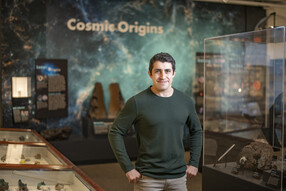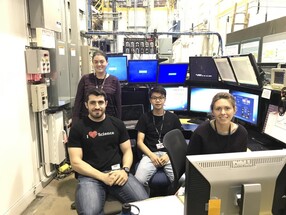Core Concerns
Digging deep into Martian geology for new knowledge of how planets form

Research at Risk: Since World War II, universities have worked with the federal government to create an innovation ecosystem that has yielded life-changing progress. Now much of that work may be halted as funding is withdrawn. Find out more about the threats to medical, engineering, and scientific research, as well as how Harvard is fighting to preserve this work—and the University's core values.

The stunning photos transmitted from NASA’s InSight lander made Mars look like a nice place to visit—but you wouldn’t want to stay there long. Even if you brought your own air to breathe and water to drink, the low gravity environment would soon cause your organs to fail. If that didn’t do you in, the cancer you developed due to the planet’s radiation probably would.
Most folks would be happy to keep at least 34 million miles—the minimum distance between Mars and Earth—between them and such a hostile environment. But not GSAS student Matt Brennan. For him, Mars rocks.
“Of course I’d like to go to Mars,” he says. “I’d land on the surface, gather up an armful and head back to Earth. Astronauts can pick up rock samples much more easily than a robot. It’s a worthy scientific endeavor.”
If Brennan’s willingness to spend a year in space just to scoop up a few stones sounds like madness, there is a method to it. As a PhD candidate in Harvard’s Department of Earth and Planetary Sciences, Brennan studies Mars, how it formed, and what’s at its core. He says that the data that NASA’s missions collect on the planet’s geology are helping him shed light on the way that Mars developed, and so give scientists a better understanding of the origins of the Earth and the rest of its neighbors in the solar system.
Crucial InSight
Brennan’s enthusiasm for rock samples from Mars is understandable when you consider how little planetary scientists have had to work with up to now. Virtually all that’s known about the planet’s geology is derived from a collection of about 280 meteorites ejected from Mars around a billion years ago.
"It's less than 200 pounds of material,” Brennan says. “Our entire knowledge of the geochemistry of deep Mars is based on that. So, the idea of retrieving pristine rocks and bringing them back is very important, but it’s unlikely to happen for at least a decade. The Perseverance rover on Mars now is supposed to collect samples for retrieval by a future mission. Although my research focuses on igneous rocks and the rover will collect sedimentary samples, it would still be a huge step forward for the study of Martian composition.”
The fundamental problem for scientists like Brennan—whether they study the Earth or Mars—is that the vast majority of a planet’s geology is inaccessible for direct observation: too deep, too hot, too much pressure. So they have to extrapolate from meteorites and indirect physical data such as estimations of planetary mass based on the orbits of spacecraft. One of the reasons that NASA’s missions are so important, Brennan says, is that they have for the first time put a seismograph on the surface of a planet other than Earth, enabling scientists to analyze its interior more directly.
“The most direct data we can interpret is seismic,” he says. “By reconstructing the path of quake vibrations and seeing how they change, we can detect when the density of a planet increases as we go from layers of rock to layers of metal like iron, which is what the Earth’s core is mostly made of.”
While Brennan is mindful of the limitations of InSight and Perseverance, he says that the data they generate represent a major leap forward in efforts to form a picture of Mars’s geology.
“InSight was only a single lander and Mars doesn’t have a lot of seismic activity,” Brennan says, “so even if it works as well as we could imagine, it still won’t be one-millionth as good as we have on Earth. But there’s never been a seismic instrument there before, so it’s a crucial first step.”
"With ever-burning Sulphur unconsumed"
Before InSight touched down on Mars in 2018, Brennan and his advisor, Clare Boothe Luce Assistant Professor of Earth and Planetary Sciences Rebecca Fischer, collaborated with Princeton’s Jessica Irving on research that scientists could use to interpret the seismic readings registered by the lander. He and his colleagues simulated the planet’s formation based on existing data. Their model described a core constituted overwhelmingly of iron and nickel, but with a significant quantity of other, lighter elements.

“We believed that the core had some amount of sulfur—probably a lot,” he says. “Through seismic data, InSight can detect the size of the core. If it’s gigantic, that means there’s probably a lot of sulfur. Well, we’ve got the data now and it turns out that the core of Mars is gigantic.”
In fact, Brennan’s research led him to conclude that the Martian core was between 10 and 20 percent sulfur, compared to only 2 percent for Earth. “I think there’s very little oxygen and silicon in the core of Mars,” he says. “Those are the other candidates in terms of light elements.” While there is still some debate about this assertion in scientific circles—and about what portion of the light elements in the Martian core is comprised by sulfur—the frame of reference that researchers use to think about the composition of the core has shifted.
“Some people think that there must be a combination of a lot of oxygen and a lot of sulfur,” he says. “But now that InSight has confirmed that the core is so large, I think maybe the debate is whether sulfur accounts for 80 percent of the light element content or 50 percent, not whether there’s sulfur at all. Understanding how that happened—how the core became so enriched and sulfuric—will tell us a lot about what makes Mars and Earth different.”
We’ve got the data now and it turns out that the core of Mars is gigantic.
-Matt Brennan
Knowledge of the distinct composition and formation of Mars is important not only for our understanding of Earth’s origins, Brennan says, but also of the way our entire solar system was formed. That’s because the protoplanetary disc out of which the planets emerged four billion years ago left its fingerprints on the large-scale variations between them.
“The things we know about Mars,” Brennan says, “that it’s one-tenth the mass of the Earth, that it has no air or water, that it’s red because of this weird iron oxide layer, and now, that it’s got a large core with a lot of sulfur—these are all things that are dependent on the specific conditions of how it developed. By piecing together the differences between it and Earth, we get a better picture of how planets form in general.”
Fischer says that her advisee’s research—particularly on the light elements in the Martian core—bring into finer relief the composition of the planet. Brennan’s models of Mars’s interior tell scientists like those working on the NASA missions how the size of the planet’s core is related to different factors like its composition, density, and temperature.
“Now that InSight has measured the size of the core,” she says, “we can use that information in the future to better understand these factors based on Matt’s work. By making testable predictions about core size and density, thermal structure, and other properties, and how these affect the propagation of seismic waves, his research will help the InSight team better interpret their observations.”
Moreover, Fischer says that the kinds of models Brennan builds can inform research on the formation and geophysical properties of rocky planets like Mercury, Venus, and Earth, as well as those that revolve around other stars.
“We already knew more about how Earth formed since it’s the planet we live on,” she says. “Now having another planet as a data point lets us look more at general trends across our solar system and beyond. Matt’s work helps us to know where we should expect similarities or differences between them.”
Brennan is on track to finish his PhD program this year and graduate in May 2022. Then he hopes to continue on to a career in academia. With discoveries every day from missions like InSight and Perseverance, he says that it’s a “fun time” to be a planetary scientist.
“Mars is the frontier of my field,” he says. “In high-pressure mineralogy, you don’t get new observational data very often. To get seismic data from another planet—it’s the first time it’s ever happened in history. That’s pretty exciting!”
Photo by Tony Rinaldo; Banner courtesy of Shutterstock
Get the Latest Updates
Join Our Newsletter
Subscribe to Colloquy Podcast
Simplecast





